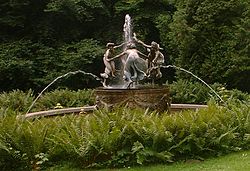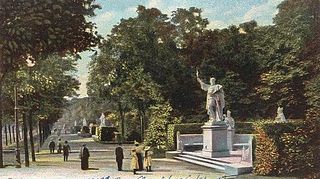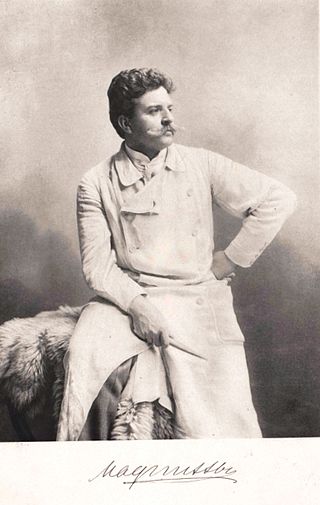
Walter Schott (18 September 1861, Ilsenburg - 2 September 1938, Berlin) was a German sculptor and art professor.

Walter Schott (18 September 1861, Ilsenburg - 2 September 1938, Berlin) was a German sculptor and art professor.
His father, Eduard Schott , was a well-known metallurgist who was the manager and inspector at the smelters of Count Heinrich zu Stolberg-Wernigerode. After completing his standard education, he studied in Hanover from 1880 to 1883, at the Prussian Academy of Arts under Fritz Schaper. [1]
After 1885, he worked as a free-lance sculptor in Berlin, creating statues in the prevailing Neo-Baroque style. [2] Over the years, he became almost totally dependent on the Kaiser's patronage and found little work to do after World War I, a fate which befell many creative artists too closely associated with the Imperial government. [1] In 1930, he wrote an autobiography, defending his position and assailing his critics.
He died in poverty. His remains were cremated and his ashes placed in an urn at his father's grave in Ilsenburg.


The Siegesallee was a broad boulevard in Berlin, Germany. In 1895, Kaiser Wilhelm II ordered and financed the expansion of an existing avenue, to be adorned with a variety of marble statues. Work was completed in 1901.

Harro Magnussen was a German sculptor.

Adolf von Donndorf was a German sculptor.

A large number of monuments were erected in Germany in honour of Emperor William I. As early as 1867 the Berlin sculptor, Friedrich Drake, had created the first equestrian statue, that portrayed William I as the King of Prussia. To date the Prussian Monument Institute has recorded:

The Schiller Monument is located in central Berlin (Berlin-Mitte) on Gendarmenmarkt, in front of the flight of steps leading up to the former royal theater, today a concert hall. It honors the poet, philosopher and historian Friedrich Schiller, who is also regarded as one of the most significant dramatists and lyricists of the German language. The set of statues was executed by Reinhold Begas a prominent 19th-century German sculptor. It is a registered historic monument.

Reinhold Carl Thusmann Felderhoff was a German sculptor and medallist.

Karl Ludwig Manzel was a German sculptor, painter and graphic artist.

Joseph Johann Ludwig Uphues was a German sculptor.

Johannes Boese, also spelled Böse, was a German sculptor and art professor.

Peter Christian Breuer was a German sculptor.

Gustav Heinrich Eberlein was a German sculptor, painter and writer.

Johannes Gottfried Götz was a German sculptor.

Albert August Karl Manthe was a German sculptor.

Cuno von Uechtritz-Steinkirch was a German sculptor.

Martin Wolff was a German sculptor.

Max Unger was a German sculptor.

Aktien-Gesellschaft Gladenbeck was a foundry located in Berlin, Germany, that operated from 1851 until 1926. During the 75-year period when the foundry was in operation it was one of the most important foundries in Germany and was known for producing high quality bronze castings.

Park Glienicke, is an English landscape garden in the southwestern outskirts of Berlin, Germany. It is located in the locality of Wannsee in the Steglitz-Zehlendorf borough. Close to Glienicke Bridge the park is open to the general public. The park is part of the UNESCO World Heritage Site Palaces and Parks of Potsdam and Berlin. Within the ensemble it is one of the five main parks, the others being Sanssouci Park, New Garden, Babelsberg Park and Peacock Island (Pfaueninsel). Regarding diversity in gardening styles within the Potsdam park ensemble Park Glienicke is only superseded by Sanssouci Park. Furthermore, it is a park especially characterized by one personality due to the intense involvement of Prince Charles of Prussia. The park covers approximately 116 hectares

Three Dancing Maidens is a nymph fountain (Nymphenbrunnen) sculpture by Walter Schott. There are three full-size versions or castings of the bronze sculpture. One is known as the Untermyer Fountain in Central Park, New York, the second one is in Antwerp’s Den Brandt Park, and the third one is in the courtyard of the Burg Schlitz castle, a grand hotel in the Mecklenburg region of northern Germany. Identification of the original sculpture created for Rudolf Mosse in 1909, and later looted by the Nazi Party is the subject of research, which appears to be leading to the version in the Burg Schlitz castle. Three-quarters scale castings, likely to be examples of the sculptor's early drafts, can be found in Germany, Austria, and Northern California.

Karl Gustav Rutz was a German sculptor.